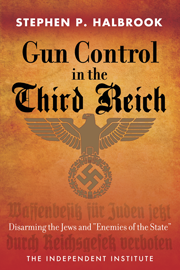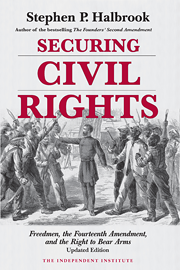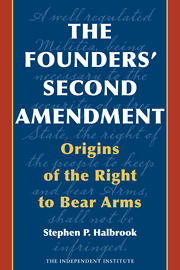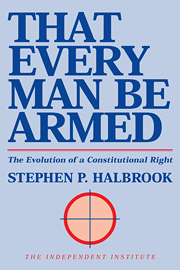As the Ukrainian President and Parliament expand civilian access to firearms, in the midst of a Russian invasion, this article is more important than ever. The article was originally published in the Ukrainian Law Journal's “Law of the USA,” Issue 2, 240-50 (2013).
The Second Amendment to the U.S. Constitution states: “A well regulated Militia, being necessary to the security of a free State, the right of the people to keep and bear Arms, shall not be infringed.” This was adopted in 1791 as part of the Bill of Rights, which also includes guarantees such as the First Amendment right to the freedoms of religion, speech, press, and assembly, and the Fourth Amendment right of the people to be secure in their persons, houses, papers and effects from reasonable search and seizure. The rest of the first ten amendments to the Constitution provide further protections of the rights of the people from abridgement by government.
As drafted and proposed in 1787, the Constitution had no Bill of Rights. Its supporters argued that paper guarantees are ineffectual, but that the people were armed and would protect their liberties. James Madison, who drafted the Constitution, replied to the argument that the federal government may raise a standing army to oppress the people: “To these would be opposed a militia amounting to near half a million of citizens with arms in their hands, officered by men chosen from among themselves, fighting for their common liberties, and united and conducted by governments possessing their affections and confidence.” They had proven themselves by defeating the British army during the Revolution. Referring to “the advantage of being armed, which the Americans possess over the people of almost every other nation,” Madison continued: “Notwithstanding the military establishments in the several kingdoms of Europe, which are carried as far as the public resources will bear, the governments are afraid to trust the people with arms.”[1]
That remains true today. Americans may lawfully possess firearms, and have a constitutional right to do so. Many governments worldwide do not trust the people with arms. But restrictions vary greatly. The United Kingdom bans most guns, but Switzerland issues assault rifles to men when they turn 20 years old for militia service. Communist dictatorships prohibited most civilians from possession of arms, but liberalization of arms laws has occurred since the fall of the Soviet Union.
Whether arms may be possessed by the people at large or should be monopolized by governments has been debated since ancient times. As noted by philosophers in ancient Greece and Rome, other animals have natural weapons such as claws and sharp teeth, but humans have the ability to make tools, including weapons. Plato envisioned an ideal state as ruled by philosopher kings whose armed auxiliaries would keep the workers in line, while Aristotle favored a polity in which citizens ruled themselves by voting on laws and bearing arms.[2]
These conflicting ideas would be reflected in English history, in which the monarchs sought to restrict arms and hunting by subjects who were not in the nobility, as well as to disarm subjects who—depending on which monarch was in power—were Protestants or Catholics. The English Declaration of Rights of 1689 decried the disarming of Protestants and declared: “That the Subjects which are Protestants, may have Arms for their Defence suitable to their Condition, and as are allowed by Law.”[3]
To vindicate the absolute rights of personal liberty, personal security, and private property, according to the jurist William Blackstone, the Declaration of Rights signified that subjects were entitled to justice in the courts, to petition the king, and “to the right of having and using arms for self-preservation and defense.” This right is “a public allowance under due restrictions, of the natural right of resistance and self-preservation, when the sanctions of society and laws are found insufficient to restrain the violence of oppression.”[4]
Those words express how the American Republic was born.[5] A time came when British rule became oppressive, treating the American colonies as vassal states to be taxed and exploited without any political representation. In 1768, as British troops sailed to American to occupy the rebellious town of Boston, a patriot wrote that “the Governor has said, that he has Three Things in Command from the [British] Ministry, more grievous to the People, than any Thing hitherto made known. It is conjectured 1st, that the Inhabitants of this Province are to be disarmed. 2d. The Province to be governed by Martial Law. And 3d, that a Number of Gentlemen who have exerted themselves in the Cause of their Country, are to be seized and sent to Great-Britain.”[6]
The occupation of Boston by a standing army quartered within the population led the colonists vigorously to assert their rights as Englishmen. The tragedy of the Boston Massacre in 1770, in which British troops shot protesters, only solidified the patriots’ commitment to protect themselves, by arms if need be.
From the Boston Tea Party through the Powder Alarm, spanning the years 1773-1775, repressive measures against the increasingly troublesome Americans sharply escalated. The Royalist-imposed government in Boston—the radicals called it “the Divan” after an institution of Turkish despotism—debated a prohibition on all private arms. General Thomas Gage’s troops seized the gunpowder in the powder houses, cutting off the supply of that essential commodity. Searches and seizures, including alleged entrapment, were instituted against those attempting to obtain and distribute arms.
Well aware that the colonists were making every effort to arm themselves, King George III sought to cut off all arms and ammunition at the source, by prohibiting the export of arms and gunpowder from Britain and elsewhere (particularly Holland), and the import of these articles into the colonies. This arms embargo was combined with stepped-up search-and-seizure operations in Boston, particularly at the Neck, the narrow strip of land where patriots were smuggling large quantities of munitions to the countryside.
The “shot heard ‘round the world” at Lexington and Concord in 1775 entailed the Redcoats’ attempted seizure of arms being hoarded by militiamen and the repulse of these troops by the local citizens armed with their own muskets and sporting arms. This led General Gage to impose the confiscation of all firearms from Boston’s civilians, under the promise that those in compliance could depart the besieged city. After seizing the arms, “the perfidious Gage” held the townsfolk as hostages.
During these years, history was not standing still in the other colonies. The patriots in such colonies as Virginia, Pennsylvania, and New York were being radicalized because of events in Boston, and the British authorities saw Boston as the root of all evil in the colonies. The Boston experience showed that many colonists were armed or sought to obtain arms, and that Gage’s successful and unsuccessful attempts to disarm them constituted yet more proof of the Crown’s objective to destroy their rights as Englishmen.
The above were key events which led the Founders to adopt the Second Amendment. A tyrannical government supported by a standing army had sought to disarm a people through various artifices. It took these repressive measures against both citizens organized as militia and against citizens as individuals. The patriots then exercised their right to keep and bear arms to protect both this right and their many other rights.
The American Revolution had now been sparked. Its philosophy, as expressed in the Declaration of Independence (1776), was that the people must endure some amount of injustice, but they may wage armed resistance when injustice becomes tyranny.
Beginning in 1776 and continuing during the War for Independence, the States took measures to provide for their own governance. Virginia was the first State to adopt a declaration of rights, which included the admonition for “a well regulated Militia, composed of the Body of the People, trained to Arms.” And Pennsylvania was the first to declare that “the people have a right to bear arms for the defense of themselves and the state.” These principles were held dear in all of the States, without regard to whether they adopted a bill of rights. Some deemed it unnecessary to list the many rights of mankind in a formal instrument.
With independence won and rights vindicated, the next phase of the Second Amendment’s saga begins with the drafting of the Constitution at the Philadelphia convention in 1787. Its lack of a bill of rights was defended in The Federalist Papers and attacked by the Antifederalists. But both sides agreed with the ideal of an armed populace.
The proposed Constitution was then considered by the conventions of the thirteen States, largely in 1788. In the initial phase, those demanding a bill of rights protecting free speech or any other right could not muster a majority in any convention. However, the Pennsylvania Minority proposed that “the people have a right to bear arms” to defend themselves, the State, and the United States, and for hunting. In the Massachusetts convention, Samuel Adams proposed that “peaceable citizens” have a right to keep “their own arms.” Finally, the New Hampshire convention became the first to propose a bill of rights, including that “Congress shall never disarm any citizen” unless in rebellion.
It was now Virginia’s turn. Patrick Henry argued “that every man be armed,” and George Mason drafted a declaration of rights, including a guarantee of “the right of the people to keep and bear arms.” James Madison and his Federalist colleagues reached the great compromise with the Antifederalists: Virginia would ratify the Constitution without a bill of rights, but one would be proposed when the first federal Congress met.
In the remaining State conventions, the majority in favor of a bill of rights had become irresistible. New York demanded one, and North Carolina refused to ratify the Constitution until a bill of rights had been introduced in Congress. Recognition of the right to bear arms was repeatedly demanded.
James Madison lived up to his promise and introduced what became the Bill of Rights, including the Second Amendment, in the first session of Congress in 1789. The Federalist Tench Coxe explained: “As civil rulers, not having their duty to the people duly before them, may attempt to tyrannize, and as the military forces which must be occasionally raised to defend our country, might pervert their power to the injury of their fellow-citizens, the people are confirmed . . . in their right to keep and bear their private arms.”[7] The Bill of Rights was ratified by the States in 1791.
Meanwhile, the nature of a well regulated militia was debated in Congress. The Militia Act of 1792 would require that all able-bodied white males enroll in the militia and provide their own arms. Bearing arms was considered both a right and a duty. As Thomas Jefferson would write: “The constitutions of most of our States assert, that all power is inherent in the people; . . . that it is their right and duty to be at all times armed; that they are entitled to freedom of person, freedom of religion, freedom of property, and freedom of the press.”[8]
During the antebellum period—from the birth of the Republic through the Civil War—Americans could freely keep and bear arms without restriction, except for two. First, particularly in the Southern States, it was a crime to carry weapons concealed, but not openly. Second, the Slave Codes prohibited slaves, and in some cases free blacks, from keeping or bearing arms.
When the War Between the States ended in 1865, the period of Reconstruction began.[9] But the Southern States reenacted the Slave Codes in the form of the Black Codes. Freedmen, the former slaves, were prohibited from keeping or carrying a firearm without a license from the authorities, and state militias searched their cabins for arms. African Americans complained about this and other deprivations to Congress, which passed legislation to protect their rights. The Civil Rights Act of 1866 sought to invalidate the Black Codes, but Southern courts declared it unconstitutional and upheld criminal convictions of blacks who possessed firearms for hunting and self defense.
Congress also passed the Freedmen’s Bureau Act, which declared protection for the “full and equal benefit of all laws and proceedings concerning personal liberty, personal security, and . . . estate . . ., including the constitutional right to bear arms . . . .”[10] As noted above, similar language had been used by William Blackstone in the eighteenth century.
These events gave rise to the Fourteenth Amendment to the Constitution. Previously, the Bill of Rights was held to apply only to the federal government, not to the states. To ensure that the states could not violate fundamental rights, the Fourteenth Amendment was proposed in Congress. Section 1 declared:
All persons born or naturalized in the United States, and subject to the jurisdiction thereof, are citizens of the United States and of the state wherein they reside. No state shall make or enforce any law which shall abridge the privileges or immunities of citizens of the United States; nor shall any state deprive any person of life, liberty or property without due process of law, nor deny to any person within its jurisdiction the equal protection of the laws.
Introducing the Fourteenth Amendment to the Senate, Senator Jacob Howard referred to “the personal rights guaranteed and secured by the first eight amendments of the Constitution; such as freedom of speech and of the press; . . . the right to keep and bear arms. . . .” Howard averred: “The great object of the first section of this amendment is, therefore, to restrain the power of the States and compel them at all times to respect these great fundamental guarantees.”[11]
The Fourteenth Amendment was approved by over 2/3 vote of the members of Congress and then submitted to the states. By 1868, sufficient numbers of states had ratified the Fourteenth Amendment to make it part of the Constitution.
Meanwhile the Ku Klux Klan arose in the South as a movement to terrorize African Americans from voting, possessing firearms, or otherwise exercising their constitutional rights. Many incidences occurred in which blacks used firearms to protect themselves from extremist violence, as well as in which their firearms were confiscated and they were attacked and even murdered. Congress responded again with enactments such as the Civil Rights Act of 1871, which remains today as a major law used in courts to vindicate civil rights.[12] It was intended to protect fundamental Bill of Rights guarantees, including the right to keep and bear arms, and is used for that purpose today.
Reconstruction in the South ended in 1876, and a long period ensued in which the rights of blacks to vote and engage in other constitutional conduct receded and were not protected by the courts. The Supreme Court did not recognize that the fundamental guarantees of the Bill of Rights applied to the States, despite the intent of the Fourteenth Amendment. Finally, just before the turn of the century, the Supreme Court began holding that selected guarantees of the Bill of Rights applied to the States, and thus prohibited infringement of those rights by the States. But during the twentieth century, the Court would be virtually silent on the meaning of the Second Amendment and whether it applied to the States through the Fourteen Amendment.
Beginning in 1776 through today, the States have adopted their own constitutions with bills of rights, most of which have included the right to keep and bear arms, including for self-defense and defense of the State. Some State courts have robustly protected the right to keep and bear arms, while others have upheld virtually all restrictions on the right.
The traditional interpretation of the Second Amendment is that individuals have a right to possess and carry firearms, and that an armed populace constitutes a militia that secures a free country. But the Second Amendment came to be denigrated by supporters of prohibitions on firearm ownership by the populace at large. Beginning primarily in the 1960s, the revisionist view became prominent that the Second Amendment secures only a “collective” power of the States to maintain militias free of federal control, and that individuals have a “right” to bear arms only in militia service. While the “collectivist” view disparages any individual right, its alternative explanation that some “right” exists to bear arms in the militia or National Guard is precluded by the commonplace discretion of military commanders to decide who shall bear arms, what arms they shall bear, and when they must do so.
After over two centuries of virtual silence, the U.S. Supreme Court held in the case of District of Columbia v. Heller (2008) that the Second Amendment guarantees the right of individuals to possess firearms for self defense, hunting, and militia service, and invalidated D.C.’s handgun ban. The 5-4 opinion, authored by Justice Scalia, held that “the right of the people to keep and bear arms” means what it literally says, and that this liberty to have arms for protection is a natural right recognized in the English tradition, was considered fundamental by the Founders, and was consistently regarded as an individual right in the nineteenth century. The Amendment “codified a pre-existing right” which “was by the time of the founding understood to be an individual right protecting against both public and private violence.”[13] The Amendment’s declaration that a militia is “necessary to the security of a free state” was premised in part on the idea that “when the able-bodied men of a nation are trained in arms and organized, they are better able to resist tyranny.” But most Americans valued “the ancient right” and “undoubtedly thought it even more important for self-defense and hunting.”[14]
Heller held that the Second Amendment protects possession of the types of arms commonly possessed by law-abiding persons for lawful purposes such as self-defense and hunting, including handguns and long guns, i.e., rifles and shotguns. Thus, “the District’s ban on handgun possession in the home violates the Second Amendment, as does its prohibition against rendering any lawful firearm in the home operable for the purpose of immediate self-defense.”[15]
Dissenting, Justice Stevens argued that the Second Amendment extended only to the individual “right to use weapons for certain military purposes”[16]—a curious position, given that militia service is a duty, and no person has a “right” to bear or use arms as he chooses in a militia or even to be a member thereof. Justice Breyer’s dissent more forthrightly argued policy—that the need for the handgun ban overrode the Second Amendment.[17] Justice Scalia responded in the majority opinion with the following classic statement:
We know of no other enumerated constitutional right whose core protection has been subjected to a freestanding “interest-balancing” approach. The very enumeration of the right takes out of the hands of government—even the Third Branch of Government [the judiciary]—the power to decide on a case-by-case basis whether the right is really worth insisting upon. A constitutional guarantee subject to future judges’ assessments of its usefulness is no constitutional guarantee at all. Constitutional rights are enshrined with the scope they were understood to have when the people adopted them, whether or not future legislatures or (yes) even future judges think that scope too broad.[18]
If the Second Amendment protects the individual right to have arms from infringement by Congress and the federal government, to which the Bill of Rights applies, does it protect that right from State and local infringement through the Fourteenth Amendment? Heller recounted the history of the Fourteenth Amendment and its design to eliminate the Black Codes, which prohibited freed slaves from possessing firearms. The Court noted: “In the aftermath of the Civil War, there was an outpouring of discussion of the Second Amendment in Congress and in public discourse, as people debated whether and how to secure constitutional rights for newly free slaves.” The Court recounted how the Fourteenth Amendment was intended to protect Second Amendment rights and questioned the applicability of nineteenth-century precedents which never actually decided the issue.[19]
In McDonald v. Chicago (2010), the U.S. Supreme Court, in another 5-4 decision, ruled that the Second Amendment applies to the states through the Fourteenth Amendment because “the right to keep and bear arms is fundamental to our scheme of ordered liberty,” and is “deeply rooted in this Nation’s history and tradition . . . .”[20] The opinion of the Court—written by Justice Alito, representing a plurality of 4 Justices—held that the right is incorporated through the Due Process Clause, while Justice Thomas would have incorporated it through the Privileges-or-Immunities Clause.[21]
McDonald followed long-standing precedent that rights considered fundamental apply to both the federal and state governments. Noting that Blackstone’s view of the fundamental nature of the right was “shared by the American colonists,” the Court continued: “The right to keep and bear arms was considered no less fundamental by those who drafted and ratified the Bill of Rights.” In its history of Reconstruction, the Court concluded that “the Framers and ratifiers of the Fourteenth Amendment counted the right to keep and bear arms among those fundamental rights necessary to our system of ordered liberty.” Refusing “to treat the right recognized in Heller as a second-class right, subject to an entirely different body of rules than the other Bill of Rights guarantees,”[22] McDonald rejected the power “to allow state and local governments to enact any gun control law that they deem to be reasonable, including a complete ban on the possession of handguns in the home for self-defense.”[23]
Since the Second Amendment is “a provision of the Bill of Rights that protects a right that is fundamental from an American perspective,” it “applies equally to the Federal Government and the States.”[24] McDonald rejected the argument that because some European countries “either ban or severely limit handgun ownership, it must follow that no right to possess such weapons is protected by the Fourteenth Amendment.” That argument was “stunning,” for example, because “many of the rights that our Bill of Rights provides for persons accused of criminal offenses are virtually unique to this country.” These include the right to a jury trial, the right against self-incrimination, and the right to counsel.[25]
While not discussed by the Court, European countries differ greatly on this subject. The United Kingdom bans handguns and most rifles, and had to make exceptions for the firearm competitions to be held during the Summer Olympics of 2012. By contrast, Switzerland encourages marksmanship with handguns and rifles, and even requires every male reaching the age of 20 years old to serve in the militia army and keep a military rifle at home.[26]
In this dawn of recognition of Second Amendment rights by the Supreme Court, lower courts are debating whether any right exists literally to “bear arms,” such as persons with permits or licenses carrying handguns. McDonald stated that in Heller, “we held that the Second Amendment protects the right to keep and bear arms for the purpose of self-defense,”[27] reflecting the Amendment’s explicit textual reference to the right to “bear arms.”[28] Most states issue permits or licences to carry handguns, so this issue arises primarily in states which only authorize privileged persons to do so.
For most of the nation’s first two centuries, few federal laws on firearms existed. The Militia Act of 1792 required every able-bodied male to provide himself with a firearm, but it was repealed in 1903. The National Firearms Act of 1934 required taxation and registration of machine guns and shotguns with barrels under 18 inches. The Property Requisition Act of 1941, in reaction to police state policies such as in Nazi Germany and Soviet Russia, included a provision prohibiting further registration of firearms possessed for personal protection or sport or other impairment of the right to keep and bear arms.[29]
The Gun Control Act of 1968—passed exactly two centuries from 1768, when colonists anticipated “that the Inhabitants of this Province are to be disarmed”—restricted interstate commerce in firearms. Registration of firearms was proposed but defeated. In the Firearms Owners’ Protection Act of 1986, that law was liberalized to require that crimes be proven to be willful or knowing. The 1993 Brady Act, which requires background checks for firearm purchasers, had a temporary provision which was declared unconstitutional under principles of federalism, but its permanent provision, the National Instant Criminal Background Check System, is the law today. A ban on new production of selected semiautomatic firearms, pejoratively called “assault weapons,” passed in 1994, but expired in 2004.
Regulation of firearms by the States varies greatly. All States, of course, punish misuse of firearms. The majority of States do not require licenses for law-abiding citizens merely to possess firearms, allow possession of ordinary rifles, pistols, and shotguns, and provide for permits to carry concealed handguns to law-abiding persons with training. A minority of States require licenses and/or registration for mere possession of firearms (or certain types of firearms), restrict possession of ordinary firearms that they call “assault weapons,” and make it difficult or impossible for ordinary citizens to obtain permits to carry handguns. These laws are being challenged in the courts.
In conclusion, America is unique in its constitutional recognition of the right of the people at large to keep and bear arms. The federal and state governments are not, as James Madison said, “afraid to trust the people with arms.” As provided by the Second Amendment, adopted with the Bill of Rights in 1791, “the right of the people to keep and bear arms, shall not be infringed.”
Notes
[1] The Federalist No. 46, Documentary History of the Ratification of the Constitution, XV, 492-93 (1984).
[2] See Stephen P. Halbrook, That Every Man Be Armed (1984), chapter 1.
[3] An Act Declaring the Rights and Liberties of the Subject, 1 W. & M., Sess. 2, c.2 (1689).
[4] I Blackstone, Commentaries on the Laws of England *143-44 (1765-69).
[5] On the pre-Revolutionary period through the aftermath of the adoption of the Constitution, see Stephen P. Halbrook, The Founders’ Second Amendment (2008).
[6] Boston Gazette, Sept. 26, 1768, at 3, cols. 1-2.
[7] Federal Gazette, June 18, 1789, at 2, col. 1.
[8] Thomas Jefferson, Writings (1984), 1491-92.
[9] On this period, see Stephen P. Halbrook, Securing Civil Rights: Freedmen, the Fourteenth Amendment, and the Right to Bear Arms(2010).
[10] 14 Stat. 173, 176 (1866).
[11] Congressional Globe, 39th Cong., 1st Sess., 2765-66 (May 23, 1866).
[12] 42 U.S.C. § 1983.
[13] District of Columbia v. Heller, 554 U.S. 570, 592, 594 (2008).
[14] Id. at 598-99.
[15] Id. at 629, 635.
[16] Id. at 636 (Stevens, J., dissenting).
[17] Id. at 681 (Breyer, J., dissenting).
[18] Id. at 834-35.
[19] Id. at 614-15, citing Stephen P. Halbrook, Freedmen, the Fourteenth Amendment, and the Right to Bear Arms (1998).
[20] McDonald v. City of Chicago, 130 S. Ct. 3020, 3036 (2010).
[21] Id. at 3050 (plurality opinion), 3058-59 (Thomas, J., concurring).
[22] Id. at 3041-42.
[23] Id. at 3046.
[24] Id. at 3050.
[25] Id. at 3044. The dissimilarity exists not just regarding procedural rights, but also substantive rights. For instance, the Fourteenth Amendment was held to incorporate the First Amendment prohibition on government establishing a religion, but some European countries have state churches. Id. at 3045.
[26] See Stephen P. Halbrook, “Citizens in Arms: The Swiss Experience,” Texas Review of Law & Politics, vol. 8, Issue 1 (Fall 2003), 142.
[27] McDonald, 130 S. Ct. at 3026. The Court quoted Mississippi’s 1865 prohibition on freedmen carrying a firearm without a license as an example of what the Fourteenth Amendment would disallow. Id. at 3038.
[28] See Stephen P. Halbrook, “No Right to ‘Bear Arms’? A Critical Analysis of United States v. Masciandaro,” 1 Wake Forest Law Review Online 116 (2011,.
[29] See Stephen P. Halbrook, “Congress Interprets the Second Amendment: Declarations by a Co-Equal Branch on the Individual Right to Keep and Bear Arms,” 62 Tennessee Law Review 597, 618-31 (Spring 1995); Stephen P. Halbrook, “‘Arms in the Hands of Jews Are a Danger to Public Safety’: Nazism, Firearm Registration, and the Night of the Broken Glass,” 21 St. Thomas Law Review 109 (2009).
















